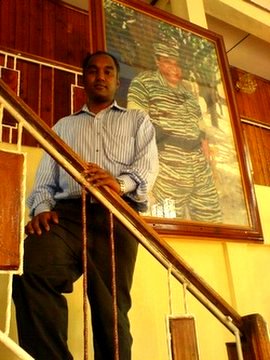
Analysis
The Strategic Importance of Sampoor
Rajesh Sundaram (New Delhi)
29 August 2006
The Sri Lankan Army, Air force and Navy have been engaged in a major offensive to retake rebel positions around the strategic Trincomalee port since 27th August.
The port town on Trincomalee is located at an elevation. Kallar, Thoppur, Seruwila, Mahindapura, Selvanagar, Pachchanoor, Kattaparichchan, Galkanda, Muttur, Ichchalanpattu and Sampoor are among a few main scattered habitations that surround Trincomalee town.
Many of these areas are under rebel control and the rebels have used their heavy guns positioned in these areas to disrupt the Trincomalee port. The rebel camps in these areas have hundreds of heavily armed fighters. The guns strategically placed at Sampoor, Ichchalanpattu and other nearby areas have caused considerable damage.
On thier part the army spokesman explains that this operation is merely to clear the area for resettlement of muslim civilians displaced five weeks ago during the ground offensive to flush the rebels out of the Maavil Aru irrigational dam.
But given the intensity of the military action, it is clear the Sri Lankan government is now determined to wrest the control of Sampoor from the rebels. The rebels say the latest army offensive into areas under their control is a clear violation of the 2002 ceasefire.
However, Sri Lankan army chief Lt. Gen. Sarath Fonseka told the Associated Press that the Security Forces had decided to retake rebel held areas around the Trincomalee port to safeguard Trincomalee naval base and its harbour. Such "defensive operations" he said " in no way go against the provisions of the Ceasefire Agreement".
The heavy guns of the rebels in and around Sampoor have continued to pound army positions in the area and the Trincomalee harbour for many weeks now.
Shelling from these positions and consequent retaliation by airforce jets and army heavy guns has also led to displacement of more than 100,000 civilians in the area.
Trincomalee harbour is the main port from where supplies to the government controlled northern district of Jaffna are sent. It is a main supply and transit port for the more than 40,000 troops stationed in Tamil majority Jaffna.
The land route to Jaffna, the A9 Kandy-Jaffna road passes through rebel held areas and hence cannot be used for military supplies.
Constant mortar fire and shelling by rebels around the only air base at Pallali in Jaffna has made troop and supply movement by air very difficult.
Therefore it is important for the Government to drive the rebels out of camps in Sampoor and nearby areas south of Trincomalee town. This they feel is the only way to make Trincomalee port safe for civilian and military movement to and from Jaffna.
Even since the offensive in Mavil Aaru and few weeks ago, Air force Kfir jets have been pounding rebel positions in areas around Trincomalee port.
The current ground offensive towards Sampoor comes after weeks of aerial bombardment by airforce jets and heavy shelling from bothsides.
More than a hundred civilians, soldiers and rebel fighters have lost their lives in the battle for Samppor so far in the past three days.
"If the Sri Lankan military aggression continued, it would set a full stop to the February 2002 Ceasefire Agreement," LTTE's military spokesman Irasaiah Ilanthirayan told Tamilnet Tuesday.
The rebels have reason to be agitated, the fall of their heavy gun positions around the strategic Trincomalee port would mean the opening of a safe supply and transit route for the troops.
India, Norway, Japan and other countries have demanded an immediate end to hostilities. But the Sri Lankan army does not seem to be in a mood to let go of strategic gains it seems to be making just yet.
Analysts say the rebels may soon open other fronts in the North and east, and could hit at government targets in Colombo using thier suicide squads.


No comments:
Post a Comment